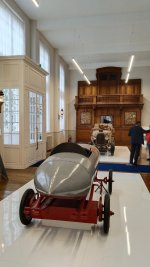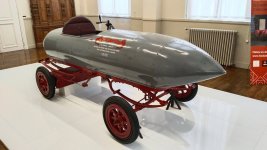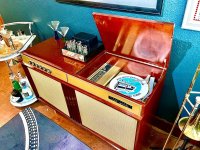I haven't got a problem with Hybrids, although I'm very happy that my new car is a full blown ICE. Last of them in this model.
Electric vehicles have been pushed too soon for too many purposes. They make sense in cities only, and for the reasons I mentioned. Maybe some day they will make sense, but not yet. The one and only reason we have ICE powered vehicles is that they are the most practical, most reliable way for getting from ! to B. This is the simple truth. EV's have been attempted throughout history as people have shown, and they were not a commercial success. This hasn't got anything to do with folks making money on gas and oil. There are many other markets for that.
Yup, takes money to transfer fuel, but electricity is generated by natural gas plants as well as other sources. There isn't energy loss in transporting fuel beyond transportation and they have made that as efficient as possible.
HOV lanes don't work. Around here they are more a problem than anything else. Thankfully the government has come to its senses and are removing bike lanes as well. Stupid idea. We got along just fine without them for over a century.
Back on topic. Similar issues with equipment. Class D isn't quite right yet, but it is't repairable long term so that supports the throw it away industry. We as a planet of people cannot afford this trend. Plus all the shipping it creates, EV or ICE (99% ICE I'll bet). That is where profits are being taken, the rest just distracts people from the real picture.
Electric vehicles have been pushed too soon for too many purposes. They make sense in cities only, and for the reasons I mentioned. Maybe some day they will make sense, but not yet. The one and only reason we have ICE powered vehicles is that they are the most practical, most reliable way for getting from ! to B. This is the simple truth. EV's have been attempted throughout history as people have shown, and they were not a commercial success. This hasn't got anything to do with folks making money on gas and oil. There are many other markets for that.
Yup, takes money to transfer fuel, but electricity is generated by natural gas plants as well as other sources. There isn't energy loss in transporting fuel beyond transportation and they have made that as efficient as possible.
HOV lanes don't work. Around here they are more a problem than anything else. Thankfully the government has come to its senses and are removing bike lanes as well. Stupid idea. We got along just fine without them for over a century.
Back on topic. Similar issues with equipment. Class D isn't quite right yet, but it is't repairable long term so that supports the throw it away industry. We as a planet of people cannot afford this trend. Plus all the shipping it creates, EV or ICE (99% ICE I'll bet). That is where profits are being taken, the rest just distracts people from the real picture.
I actually saw this car in July, it's in Napoloen's old chateau in Compiègne, it looks as it it would be very scary at 100kmh. I looked carefully but could see no wires between the mysterious box on the back axle, and the bodywork, apart from a small cable brake, so I have no idea how the power was transmitted or controlled - perhaps details were lost and this bit was rebuilt for show?!The first car to ever reach and overtake the 100 kilomètres dans l'heure car land speed record. It was in France, at Achères, near Paris, in 1899... Many years before that any thermal engine would be able to do it.
EVs in the 1800s were good, as they were lightweight, electricity was I think, free, and the batteries could be rebuilt in your shed, so the 'Right-to-repair' was top priority back then, and they did well until the oil lobby arrived.
Now we sort of have a powerful EV lobby, but we are only offered massive complexity and cost - which I think will bankrupt all but Tesla, although even that design has majot flaws (some unconnected to the propulsion system, such as 'how to open the back doors if the power goes?' and the daft electric glovebox etc).
Attachments
I have a 406, it just does everything I want it to, so I never had cause to change it 🙂I drive a Peugeot too; a 206
Rare now, thanks to the anti-green 'scrappage scheme' that removed cheap transport for the masses.
I'd quite like a Peugeot 404 convertible though, that would be a real treat 🙂
In England they generate most of the traffic, one way or another. In Portugal I get a 30 minute train ride for €2. Ine England it's about £30. Buses are similar (although National Express coaches are reasonable value).the government
So people use the road, the main traffic is for commuting. But we are taxed for moving, via 'Stamp Duty', a pernicius 'Capital Gains' tax really, and so for many it's cheaper to buy a new shiny car than move closer to work. So people do.
If they were serious about reducing traffic, they'd scrap Stamp Duty. But then again, they are not here to help us..
🙂
Peugeot has a long history in Australia, although they have never sold many cars due to over pricing by the importer. I did own a 405 Mi16 before this one - that was a fantastic car. I have owned French cars for 30 years now just for the driving experience. Also, my brother drives a Renaultsport Megane 265.
Sorry for the off topic that will be all on this...
Sorry for the off topic that will be all on this...
Last edited:
Even the 2L Ford Mondeo has a PSA engine in it, it's even in the top casting on the metal cam cover (underneath the plastic!).Peugeot
Like the VW engines in Bentleys and the Volvo parts in Aston Martins 🙂
Perhaps the purest HiFi in that sense were made by Toshiba and Hitachi - maybe Sony too - as perhaps they used more of their own parts. Shame Motorola never made hiFi...
Hmm, I stand corrected, they did start!
https://www.stereoconsole.com/stereo-console-history/motorola-stereo-console-history/
And of course car radios, which is what the middle concole appears to have.
I detect the 'small department in a huge conglomerate' syndrome here.
Attachments
Often times, the manufacturers of good parts do not make the best products. Semiconductor manufacturers have applications department focused on selling the product, not making the best <whatever> on the market. Don't forget that audio sales are tiny compared to industrial sales. Audio won't see any product unless it has far wider industrial uses.
Case in point. Sony CD players. They made pretty good laser heads (NEC made the best I have ever seen), decent chip sets for servos. They were reliable except for some ES series units (curiously, they repeated engineering errors) and they don't sound the best. But a company like Denon for example, Sony laser heads and servo chips. Then DEnon designed the rest and their upper models are some of the very best you can get. Back then anyway, but I would still buy a Denon. The standard cheaper Sony CD player was a tank, they kept going and were repairable (unlike Philips). Panasonic made reliable units also, didn't sound good though.
Case in point. Sony CD players. They made pretty good laser heads (NEC made the best I have ever seen), decent chip sets for servos. They were reliable except for some ES series units (curiously, they repeated engineering errors) and they don't sound the best. But a company like Denon for example, Sony laser heads and servo chips. Then DEnon designed the rest and their upper models are some of the very best you can get. Back then anyway, but I would still buy a Denon. The standard cheaper Sony CD player was a tank, they kept going and were repairable (unlike Philips). Panasonic made reliable units also, didn't sound good though.
I had a Panasonic DVD that sounded very good, indeed it had Muse caps along the signal path and KZ in the supply... just to say.
Ok, new term. "Phase molestation". I like itI'll take a shot. Whatever frequencies comprise the "Timbre" of a sound must remain unmolested in both relative level and phase. So if you have a pile of harmonically related frequencies, such as a guitar would make and the relative levels of each as they decay is preserved, but - say - the phase of ever other harmonic is flipped somehow, you'd probably hear that. I'm pretty sure phase molestation by some audio component is measurable.
There's a way to engineer a circuit so that it's individual distortion components can be "in" or "out" of phase, relative to a driving signal. I certainly dont know how to do that - others on this forum do, I'd bet. I've read they say it makes a difference, so that too.
These things can be measured at input and output, compared.
The proper fix, for as long as I have done this, is to pin all of the pass throughs on the Dolby board, making sure the pins (old capacitor leads) are set and soldered nicely. Not difficult from a technical standpoint, but tedious as ****. Great sounding, and actually quite reliable receivers when this is done, along with rooting out all of the fusible resistors.Hi!
I looked the issue of the Sansui 8080DB and 9090DB dolby wiring and bypass a little last night, once some pins are numbered, and some pin numbers corrected, it becomes a rather simple task, even if the schematic and PCB layout are sometimes at odds with each other 🙂
Of course I may have made a mistake, but essentially I think my method is correct:
A picture is worth a thousand words (see pic), so this is my way to properly bypass the board with 4 jumper wires, and by moving the input from the F-2655 daughterboard to the F-2654 switch board, which is where it should have been anyway.
Unlike other mods, my bypass mod doesn't involve destroying the F-2655 board, that's simply left in place, ignored.
But:
As an aside however, this bypass is really just mimicking the 'Off' position on the Dolby selector switch, and in that setting I can't see anything but the dolby selector wafer switches (x3) and the tape monitor push switches (x2) - so if the signal is not getting through in the Off position it's either a broken ribbon or a dodgy switch.
I.e. The bypass simply eliminates 3x wafer switch contacts and the ribbon.
This then leads to my conclusion that the best way to fix this dolby circuit is to recap it, put a nice new flexible ribbon in it (potentially buying a swanky Silverflo vacuum desoldering station first....), and cleaning the switches - because if they, and the ribbon, are working, Off will bypass it - as designed.
😀
Well, maybe I'll give mine a shot. I hate working on them. You have to solder all top to bottom PCB connections plus all the connections between the two PCBs.
The Dolby chips cause a lot of distortion, not just this receiver. All Dolby chips are terrible for distortion. I guess it doesn't matter in a cassette deck, but this receiver has a nice amplifier design.
The Dolby chips cause a lot of distortion, not just this receiver. All Dolby chips are terrible for distortion. I guess it doesn't matter in a cassette deck, but this receiver has a nice amplifier design.
When Dolby mode is selected to off, the Dolby chips aren't a factor. Only the main Dolby board, the one with the wafer switch, has the pass throughs, IIRC. FWIW, I don't think I have ever had to replace the ribbon cable.
I thought I traced the signal through the chip in pass-through. It may have been another unit.
But. My measured distortion was much higher than the amplifier section alone measured.
But. My measured distortion was much higher than the amplifier section alone measured.
I was looking at the schematic, and pin 7 (for the left channel) of the NE545B Dolby chip is connected in parallel with the signal path when the selector is in the off position. At the switch position, the input to the chip is grounded. Theoretically it shouldn't interfere. So, when it's Dolby is selected off, the signal isn't going through the chip, but the chip is in parallel with its input grounded.
Another thing is the BA312 in some applications, the tone controls in this unit, were barely biased on, and as they drift over the years will cause some distortion. Upping the bias on them seems to fix the problem, or replacing them with a discrete solution.
Also, there are three fusible resistors in the regulated power supply that drift and cause diminished voltage and current in the unit.
Another thing is the BA312 in some applications, the tone controls in this unit, were barely biased on, and as they drift over the years will cause some distortion. Upping the bias on them seems to fix the problem, or replacing them with a discrete solution.
Also, there are three fusible resistors in the regulated power supply that drift and cause diminished voltage and current in the unit.
I'll look at the signal path again. It's been several years since I considered repairing it. I've repaired many others. As long as the Dolby chip output is disconnected, all should be good. If it still connects you have a possible noise source. I thought they simply switched between that and something else, but the board did provide gain I thought. Too many years to remember clearly.
The BA312 is well known and used in many brands. Something else to consider is replacing it with a custom op amp adapter PCB. If you're going to improve performance, this would be one spot that makes a lot of difference. And yes, always check fusible and power resistors.
The BA312 is well known and used in many brands. Something else to consider is replacing it with a custom op amp adapter PCB. If you're going to improve performance, this would be one spot that makes a lot of difference. And yes, always check fusible and power resistors.
Those were just the things I could think of off the top of my head with that unit. It's been a few years since I worked on one. There are some good and inexpensive BA312 replacement boards on the market these days that use three transistors and four resistors. Better than the $100+ opamp board solutions, IMO, since BA312 really isn't an opamp.
Another cool thing with the x0x0DB receivers is to replace the fusible resistors at the meter lamps with resistor and a diode and install white 3mm leds. There are also eight or so fusible resistors on the driver board.
Another cool thing with the x0x0DB receivers is to replace the fusible resistors at the meter lamps with resistor and a diode and install white 3mm leds. There are also eight or so fusible resistors on the driver board.
I see a couple on Ebay for $2400 USD. Not even restored. And no wood case either.Just checked a Marantz 2325 on ebay 3400$! Crazy!
jeff
Well, the wood case traps heat. The ones without a wood case would be the best ones.
I have one, had two others. They are excellent receivers.
I have one, had two others. They are excellent receivers.
Just checked a Marantz 2325 on ebay 3400$! Crazy!
At those prices, why not McIntosh? I see a couple 30 WPC MAC 1500s have gone for same or less. Era style / appearance on par, I'd say; same with other similar vintage Mac receivers.I see a couple on Ebay for $2400 USD.
- Home
- Member Areas
- The Lounge
- Antique gear




